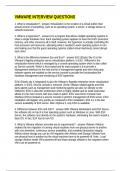Exam (elaborations)
VMware Interview Questions
- Course
- Institution
1. What is virtualization? - answer-Virtualization is the creation of a virtual (rather than actual) version of something, such as an operating system, a server, a storage device or network resources. 2. What is a Hypervisor? - answer-It is a program that allows multiple operating systems to sha...
[Show more]



